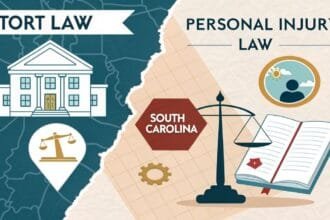Getting injured because of someone else’s conduct is stressful enough. On top of the pain or disability, you may face mounting medical bills, lost wages, insurance adjusters, and the uncertainty of what comes next.
If you are in California and you are considering going the legal route, it’s important to understand your rights, the procedural steps, and the strategic questions you and your attorney will navigate.
This guide breaks down how to file a personal injury lawsuit in California – step by step – so you know what to expect.
1. Understand Your Right to File a Personal Injury Lawsuit
A “personal injury” lawsuit refers broadly to a civil claim brought by someone who has been harmed (physically or sometimes psychologically) because of someone else’s fault.
In California, you may have grounds to file if another party’s negligence (carelessness or recklessness) caused your injury and resulting losses – medical bills, lost wages, pain and suffering, etc.
Examples include: car accidents, pedestrian accidents, slip-and-fall incidents, trucking collisions, construction injuries, or other accidents where someone failed to act safely.
California’s court self-help guide explains that to sue, you must identify who is responsible and what your damages are.
Key things to check:
- Was someone else’s negligence (duty → breach → causation → damages) present?
- Did you suffer measurable losses (medical costs, lost income, impairment)?
- Is the defendant someone who can legally be held liable (driver, property owner, manufacturer, employer, etc.)?
Not all accidents create viable lawsuits, but if you have strong indications of another party’s fault, the process may be worthwhile.
Know California’s Statute of Limitations
Time is critical. In California, you generally have two years from the date of injury to file a personal injury lawsuit. If you miss that window, your case will almost always be barred (you lose your right to have the court hear the case).
There are exceptions worth noting:
- Claims against a government entity (state/local) often have much shorter deadlines and require prior notice under the Government Claims Act (formerly known as the Tort Claims Act) – typically six months.
- Cases where the injury wasn’t discovered right away (“discovery rule”) may allow the clock to start when you reasonably should have known you were injured.
- If the injured person is a minor, the limitations period might be tolled until they reach majority.
3. Identify the Liable Party (or Parties)
You must figure out who is legally responsible (liable) for your injury. In simple cases, this is obvious – e.g., a driver who runs a red light. But in many claims, multiple parties may share responsibility: property owners, business tenants, product manufacturers, government agencies, employers, subcontractors, etc.
In negligence cases, you typically must show that:
- The defendant owed you a legal duty of care,
- They breached that duty,
- Their breach caused your injury,
- You suffered damages.
For product liability cases, California law sometimes imposes strict liability (you need not prove fault but only that the product was defective and caused your injury).
Identifying all potentially liable parties strengthens your case – your lawyer will investigate whether someone else may bear fault (for example, employer-vicarious liability for an employee driver).
4. Gather Strong Evidence for Your Lawsuit
Evidence forms the backbone of any personal injury claim. Without solid evidence, you cannot establish negligence, liability, or your damages.
The California courts highlight that evidence may include: accident scene photos, witness statements, medical records, and police/accident reports.
What should you do early?
- Seek immediate medical treatment and make sure your injuries are documented properly (initial injuries, follow-up visits, therapy).
- Photograph or video the accident scene, hazard conditions, your injuries, any vehicle damage, signage, or lack thereof.
- Get and preserve witness contact information and statements.
- Collect all receipts, bills, pay stubs, or proof of lost wages, transportation to/from doctor, rehabilitation costs, etc.
- Keep a diary or journal of how your injuries affect your daily life (pain levels, limitations, missed activities) – courts increasingly view these personal records as helpful. Also, in 2025, California litigation is trending toward more rigorous digital-evidence standards: surveillance video, phone records, social media postings, and other digital traces may become critical.
- When your attorney prepares your case, they will use this evidence to build a demand and, if necessary, prepare for litigation.
Also See: 5 Best Car Accident Lawyers in Los Angeles
5. File Your Personal Injury Complaint in California Court
Once your attorney determines you have a viable claim and the evidence is gathered, the formal lawsuit begins by filing a complaint (sometimes called a “petition” or “plaint”) in the appropriate court.
In California, personal injury lawsuits are generally filed in the Superior Court of California of the county where the injury occurred or where the defendant lives or does business.
The complaint typically contains:
- Identification of the parties (plaintiff/injured person and defendant(s)),
- A statement of facts (what happened, when, where, how),
- Your legal basis for the claim (negligence, product liability, etc.),
- The damages you seek (medical, lost wages, pain/suffering, etc.).
Once filed, the court assigns a case number, and the lawsuit is officially underway. Filing improperly or missing required attachments may delay your case or weaken the claim – your attorney must carefully draft this document.
6. Serve the Defendant Properly Under California Law
After filing the complaint, you must serve (“serve process” on) the defendant(s) with the summons and complaint – meaning you provide proper legal notice. California imposes specific rules governing who can serve, how service must occur, and by what deadline.
Common methods: in-person service by a sheriff or registered process server; in some cases, substituted service or mail/ publication may be allowed, but under strict conditions. Improper service can cause the defendant to challenge your case or delay it significantly.
Once served, the defendant typically has 30 days (in most counties) to file a response (but confirm local rules) — once the case is “joined,” the litigation clock starts running.
7. Review the Defendant’s Response
After service, the defendant will respond – often by filing an answer to your complaint, admitting or denying various allegations, or sometimes by filing a motion to dismiss or strike some aspects of your claim. They will likely assert defenses such as:
- Denial of liability or causation,
- Allegation that you share fault (comparative negligence), which under California law reduces your recovery proportionally,
- Insufficient evidence or issues of proof.
Your attorney will analyze the defense strategy and develop a plan for how to counter these defenses – for example, by strengthening your evidence or preparing to mitigate the defense’s claims of your own fault.
8. Navigate the Discovery Process
Discovery is the phase where both sides exchange information, documents, take depositions (sworn witness testimony outside court), serve interrogatories (written questions), request production of evidence, etc.
In California personal injury litigation, discovery is critical because:
- It reveals the strengths and weaknesses of each side’s case,
- It often prompts settlement negotiations once the full picture is revealed,
- It sets the stage for a potential trial by clarifying witness testimony and evidence.
Timeframes vary, but discovery typically occupies many months (maybe 6–12 months or more), especially in complex cases.
Your cooperation is vital: you must produce medical records, give testimony, attend your deposition, and help your attorney prepare.
9. Negotiate for a Settlement Before Trial
It is very common (in fact, most personal injury cases settle) that before tria,l you engage in negotiations with the defendant’s insurance company (or with the defendant directly) to reach a settlement.
Why a settlement?
- It is faster, less expensive, and avoids the uncertainty of a jury verdict.
- You get control over the outcome and timing rather than leaving it to a court.
- Insurance companies prefer settling rather than risk larger payouts at trial if liability is clear.
What you should do: - Your attorney will likely craft a demand letter summarizing your case and requesting compensation.
- The opponent will respond with an offer. Negotiations may go back and forth.
- Settlement should reflect your full losses – medical costs, lost wages, future care, pain and suffering — and account for your risk. Note: In California, once you finalize a settlement, you typically release the defendant from future liability in exchange for payment.
- According to a 2025 update, after settling, the insurance company must pay within 30 days (though it depends on the case) in California.
- If the offer is inadequate, your attorney may recommend proceeding to trial.
10. Prepare for and Go to Trial (if necessary)
If a settlement cannot be reached, your case will head to trial. The trial process involves: jury selection (unless both sides waive jury and opt for a judge trial), opening statements, direct and cross-examination of witnesses, presentation of evidence, closing arguments, and then a jury or judge verdict. Important to know:
- Trial preparation is intensive: prepping you as plaintiff for testimony, prepping witnesses, expert witnesses, finalizing exhibit lists, motions in limine (requests to exclude certain evidence), etc.
- Timeline: According to recent 2025 data, many California personal injury cases that go to trial may take 1–3 years or longer from filing.
- Risk & reward: Trials are riskier (you could get less than a settlement or even lose), but sometimes a large verdict is possible.
If you reach a verdict, either side may file post-trial motions (for judgment notwithstanding the verdict, motion for new trial) or appeal, adding time and complexity.
What Happens After a Settlement or Verdict?
Once your case ends, you must ensure all bills and liens are paid (medical providers, hospitals, workers’ compensation, Medicare/Medicaid if applicable). In California, the settlement agreement or judgment typically dictates how payment is made.
Your attorney will help you understand net recovery (what you receive after attorney fees, costs, and liens). This is an important consideration when deciding whether to accept a settlement or go to trial.
Why Having a Good Attorney Matters
Filing and navigating a personal injury lawsuit in California is complex: strict deadlines (statute of limitations), complicated service rules, detailed procedural steps, evidence requirements, and strategic decisions.
As recent commentary notes, the landscape is evolving (digital evidence, more aggressive insurance defense, new legal developments), meaning it pays to have experienced and up-to-date legal representation.
Many people believe they can “go it alone,” but without legal guidance, you risk missing deadlines, accepting too low a settlement, failing to identify all liable parties, or stumbling in discovery or trial.
A competent attorney gives you a practical roadmap, protects your rights, handles negotiations, and coordinates all the moving pieces.



